Accuracy of non-invasive methods for assessing the progress of labor in the first stage: a systematic review and meta-analysis
- PMID: 35915400
- PMCID: PMC9341104
- DOI: 10.1186/s12884-022-04938-y
Accuracy of non-invasive methods for assessing the progress of labor in the first stage: a systematic review and meta-analysis
Abstract
Background: The World Health Organization in recent years has emphasized reducing the possibility of unnecessary interventions in natural childbirth, but little is known about the accuracy of non-invasive methods when assessing the progress of labor. This paper presents a literature review to assess strategies that support non-invasive methods for labor during the first stage. It evaluates the available evidence to provide the most suitable assessments and predictions that objectively identify the progress of low-risk labor during the first stage of labor.
Methods: A search for relevant literature was conducted using the electronic databases of PubMed, CINAHL, Web of Sciences, the Cochrane Library, Scopus, Medline (OVID), and CEPS, with publications up to November 2021. Records were screened against pre-specified inclusion/exclusion criteria and the potential papers from Google Scholar were examined to identify additional papers that may have been missed. The Quality Assessment of Diagnostic Accuracy Studies-2 (QUADAS-2) tool was used to appraise the methodological quality of the included studies. The certainty of the evidence was assessed using the Grading of Recommendations Assessment, Development, and Evaluation (GRADE) approach. Two independent investigators extracted the review's characteristics, and discrepancies were resolved by consensus. This review calculated individual and pooled sensitivity, specificity, and positive predictive values, which were exported to STATA (version 14; Stata Corp., College Station, TX) to represent the performance of diagnostic testing.
Results: Our search returned 2283 reports of which 13 fulfilled the inclusion criteria, accounting for 2594 women. The subjects were divided into groups according to the diagnostic tests used to assess the progress of their labor, including appearance assessment and sonographic imaging parameters (head perineum distance, HPD; angle of progression, AOP, and other parameters). HPD pooled sensitivity was 0.74 (0.65-0.82), and specificity was 0.77 (0.69-0.84). The pooled diagnostic odds ratio (DOR) was 8.21 (4.67-14.41) and 10.34 (5.02-21.27), respectively. The results of subgroup analysis showed that the summary sensitivity and specificity were of medium accuracy overall. The quality of evidence as assessed with GRADE was low.
Conclusion: Vaginal examination is an intrinsic element in the use of the partogram, while transperineal ultrasound can also be used as an auxiliary tool. However, the presence of publication bias within the parameters of ultrasound indicates that the diagnostic performance may be overestimated. Thus, randomized controlled trials or large-scale prospective cohort studies are necessary.
Keywords: Intrapartum ultrasound; Meta-analysis; Purple line; Sensitivity; Specificity; Systematic review; Vaginal examination.
© 2022. The Author(s).
Conflict of interest statement
The authors declare that they have no competing interests.
Figures
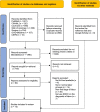
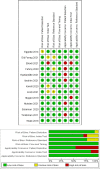
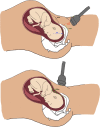
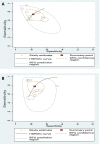
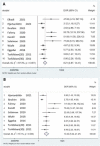
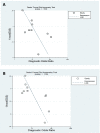
Similar articles
-
Labor progress determined by ultrasound is different in women requiring cesarean delivery from those who experience a vaginal delivery following induction of labor.Am J Obstet Gynecol. 2019 Oct;221(4):335.e1-335.e18. doi: 10.1016/j.ajog.2019.05.040. Epub 2019 May 30. Am J Obstet Gynecol. 2019. PMID: 31153931
-
Factors that affect ultrasound-determined labor progress in women undergoing induction of labor.Am J Obstet Gynecol. 2019 Jun;220(6):592.e1-592.e15. doi: 10.1016/j.ajog.2019.01.236. Epub 2019 Feb 5. Am J Obstet Gynecol. 2019. PMID: 30735668
-
Intrapartum ultrasound measurement of angle of progression at the onset of the second stage of labor for prediction of spontaneous vaginal delivery in term singleton pregnancies: a systematic review and meta-analysis.Am J Obstet Gynecol. 2022 Feb;226(2):205-214.e2. doi: 10.1016/j.ajog.2021.07.031. Epub 2021 Aug 9. Am J Obstet Gynecol. 2022. PMID: 34384775
-
Relationship between intrapartum transperineal ultrasound measurement of angle of progression and head-perineum distance with correlation to conventional clinical parameters of labor progress and time to delivery.J Matern Fetal Neonatal Med. 2015 Aug;28(12):1476-81. doi: 10.3109/14767058.2014.958459. Epub 2014 Sep 29. J Matern Fetal Neonatal Med. 2015. PMID: 25163523
-
Ultrasound for diagnosis of birth weight discordance in twin pregnancies.Cochrane Database Syst Rev. 2021 Mar 9;3(3):CD012553. doi: 10.1002/14651858.CD012553.pub2. Cochrane Database Syst Rev. 2021. PMID: 33686672 Free PMC article.
Cited by
-
Alternative approach to monitoring labor: purple line.BMC Pregnancy Childbirth. 2025 Feb 18;25(1):180. doi: 10.1186/s12884-025-07300-0. BMC Pregnancy Childbirth. 2025. PMID: 39966765 Free PMC article.
-
Methods to reduce the number of vaginal examinations in labour progress assessment so as to support normality at childbirth.Arch Gynecol Obstet. 2024 Mar;309(3):1115-1117. doi: 10.1007/s00404-023-07213-3. Epub 2023 Sep 27. Arch Gynecol Obstet. 2024. PMID: 37755533 Free PMC article. No abstract available.
References
-
- World Health Organization. WHO recommendations on intrapartum care for a positive childbirth experience: World Health Organization; 2018. 210p. https://apps.who.int/iris/bitstream/handle/10665/260178/9789241550215-en.... - PubMed
Publication types
MeSH terms
Grants and funding
LinkOut - more resources
Full Text Sources
Medical

